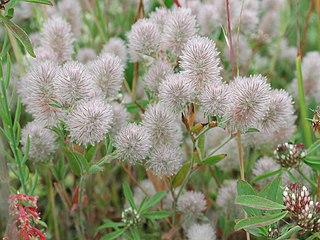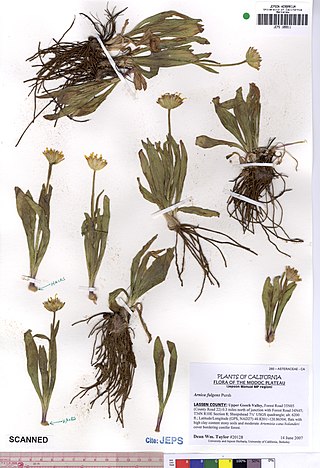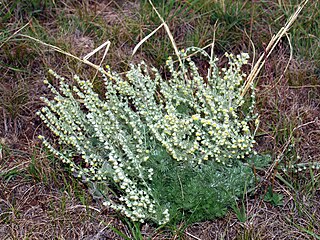
Echinacea angustifolia, the narrow-leaved purple coneflower or blacksamson echinacea, is a species of flowering plant in the family Asteraceae. It is native to North America, where it is widespread across much of the Great Plains of central Canada and the central United States, with additional populations in surrounding regions.

Trifolium arvense, commonly known as the hare's-foot clover, rabbitfoot clover, stone clover or oldfield clover, is a flowering plant in the bean family Fabaceae. This species of clover is native to most of Europe, excluding the Arctic zone, and western Asia, in plain or mid-mountain habitats up to 1,600 metres (5,200 ft) altitude. It grows in dry sandy soils, both acidic and alkaline, soil with dry-mesic conditions and is typically found at the edge of fields, in wastelands, at the side of roads, on sand dunes, and opportunistically in vineyards and orchards when they are not irrigated.

Linum lewisii is a perennial plant in the family Linaceae, native to western North America.

Rhamphospermum arvense, the charlock mustard, field mustard, wild mustard, or just charlock, is an annual or winter annual plant in the family Brassicaceae. It is found in the fields of North Africa, Asia, Europe, and some other areas where it has been transported and naturalized. Pieris rapae, the small white butterfly, and Pieris napi, the green veined white butterfly, are significant consumers of charlock during their larval stages.

Allium cernuum, known as nodding onion or lady's leek, is a perennial plant in the genus Allium. It grows in open areas in North America.

Primula pauciflora, the pretty shooting star, few-flowered shooting star, dark throat shooting star or prairie shooting star, is a species of flowering plant in the primula family Primulaceae. It is a widespread and very variable species, native to western North America, from Subarctic America to Mexico, often in xeric and desert habitats. It is found in the Great Basin Deserts and Mojave Desert. Its synonyms include Dodecatheon pauciflorum and Dodecatheon pulchellum.

Cerastium glomeratum is a species of flowering plant in the family Caryophyllaceae known by the common names sticky mouse-ear chickweed and clammy chickweed. It is native to Europe, Macaronesia to Assam but is known on most continents as an introduced species. It grows in many types of habitat. The blooming period is February, March, April, and May.

Ratibida columnifera, commonly known as upright prairie coneflower, Mexican hat, and longhead prairie coneflower, is a perennial species of flowering plant in the genus Ratibida in the family Asteraceae. It is native to much of North America and inhabits prairies, plains, roadsides, and disturbed areas from southern Canada through most of the United States to northern Mexico.

Eriogonum flavum is a species of wild buckwheat.

Arnica fulgens is a species of arnica known by the common names foothill arnica and hillside arnica. It is native to western North America, from British Columbia east to Saskatchewan and south as far as Inyo County, California, and McKinley County, New Mexico. It grows in open, grassy areas.

Cerastium fontanum, also called mouse-ear chickweed, common mouse-ear, or starweed, is a species of mat-forming perennial or, rarely, annual plant. It is native to Europe but introduced elsewhere. Its identifying characteristics are tear-shaped leaves growing opposite one another in a star pattern, hairy leaves, and small white flowers. Mouse-ear chickweed typically grows to 4"-8" tall and spreads horizontally along the ground via the formation of roots wherever the stem falls over and contacts the ground.

Abronia fragrans, the sweet sand-verbena, snowball sand-verbena, prairie snowball or fragrant verbena, is a species of sand verbena.

Crepis occidentalis is a North American species of flowering plant in the family Asteraceae known by the common names western hawksbeard, or largeflower hawksbeard. It is native to western Canada and the western United States.

Antennaria microphylla is a stoloniferous perennial forb in the family Asteraceae. It is widespread across northern and western North America, from Alaska and the three Canadian Arctic territories east to Quebec and south to Minnesota, New Mexico, and California.

Antennaria parvifolia is a species of flowering plant in the family Asteraceae, known by the common names small-leaf pussytoes and Nuttall's pussytoes. It is native to western and central North America.

Liatris punctata is a species of flowering plant in the family Asteraceae known by the common names dotted gayfeather, dotted blazingstar, and narrow-leaved blazingstar. It is native to North America, where it occurs throughout the plains of central Canada, the central United States, and northern Mexico.

Artemisia frigida is a widespread species of flowering plant in the aster family, which is known as the sunflower family. It is native to Europe, Asia, and much of North America. In parts of the north-central and northeastern United States it is an introduced species.

Artemisia longifolia is North American species in the daisy family, known by the common name long-leaved sage or longleaf wormwood. It is native to western Canada and the north-central United States.

Heterotheca villosa, commonly known as the hairy goldenaster, is a species of flowering plant in the family Asteraceae found in central and western North America.

Astragalus crassicarpus, known as ground plum or buffalo plum, is a perennial species of flowering plant in the legume family, Fabaceae, native to North America. It was described in 1813. The fruit is edible and was used by Native Americans as food and horse medicine. It is a host of afranius duskywing larvae. It is also known as groundplum milkvetch and pomme de prairie.





















